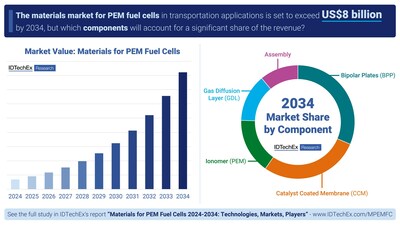PEM Fuel Cell Materials Market Growth Driven by Transportation Sector, Reports IDTechEx
Comunicato Precedente

Comunicato Successivo

As the market grows for fuel cells in transportation applications, there will be an inevitable growth in demand for materials and components for PEM fuel cells. IDTechEx have released a new report, "Materials for PEM Fuel Cells 2024-2034: Technologies, Markets, Players", which includes granular 10-year forecasts segmented by vehicle type for key fuel cell components in terms of both units and volume, while also detailing the value associated with each component. Beyond the granular market forecasts, the report includes player assessment, technology benchmarking, and analysis of trends for both materials and components incorporated in PEM fuel cells.
A PEM fuel cell consists of several key components, while multiple cells are combined to form a fuel cell stack. The bipolar plate (BPP) distributes fuel among the fuel cells before the gas diffusion layer (GDL) transports reactants and products to/from the catalyst layer respectively. The catalyst is coated on the membrane (CCM), while the membrane itself transports protons from one side of the fuel cell to the other. Collectively, the PEM, CCM, and GDL are known as a membrane electrode assembly (MEA). The PEM fuel cell for transportation market is set to grow at a CAGR of 28% between 2024 and 2034, but there are key questions to be answered with respect to the components used in fuel cells.
BPPs are the backbone of the fuel cell, providing structural support, separating the oxygen and hydrogen gas fuels, as well as collecting the current generated in the cell. Due to the number of different roles of the BPP, the choice of material must take a number of important parameters into consideration, with mechanical strength, corrosion resistance, electrical conductivity, and thermal conductivity all of vital significance, while the form factor of the flow field channels of the plates must also be considered. In the IDTechEx report, the two dominant material choices for BPPs, graphite, and metal, are benchmarked, including analysis of component suppliers, their material choices, and supply chain agreements with OEMs.
The MEA is a major component for fuel cells, incorporating the proton exchange membrane, the CCM and the GDL. The GDL is arguably the most simplistic of the fuel cell components; however, it plays a major role in water management within the cell itself. An understanding of the major players in this market segment is given in the report, together with technological differentiators and information relating to which OEMs are being supplied. Furthermore, a discussion of material trends is made with respect to enhancing the ability of the GDL to enable water management within the cell.
The PEM allows the transport of the protons from one side of the cell to the other and typically consists of a specific family of polymer known as an ionomer. The market leader is Nafion, a Chemours product; however, several other alternative ionomer materials are on the market. A major talking point regarding PEMs is the potential impact of policy regulating the use of PFAS materials, currently the dominant choice for fuel cells. IDTechEx provides benchmarking of alternative membrane materials against the incumbent with respect to three of the most important parameters for PEMs: electrical resistance, ion exchange capacity (IEC), and membrane thickness. High electrical resistance is required to ensure the fuel cell is not short-circuited, while high (IEC) and thin membranes enable rapid proton transport across the cell, thereby increasing cell performance. Alternative, novel materials are gaining traction as proton exchange membranes, such as hydrocarbon materials and metal-organic frameworks (MOFs), particularly when considering potential PFAS restrictions.
An area of critical importance for PEM fuel cells is the incorporation of a catalytic material into the cell to enable the chemical reaction to occur effectively at sub-100°C temperatures, allowing the aqueous conditions that the PEM requires for proton transport. Typically, platinum and other platinum group metals (PGMs) are utilized as catalysts. However, the high cost of these precious metals is inhibitive to the cost reduction of the overall fuel cell stack. The report from IDTechEx details the key suppliers of PGM catalysts to OEMs and forecasts the demand for PGM materials and the value associated with integrating these metals into a CCM. A focus for R&D relating to fuel cells concerns the reduction of the cost of the catalyst, either by limiting the volume of PGM required or by finding alternative catalytic materials.
For more details on the materials demand, trends, and emerging novel alternatives to the incumbents for PEM fuel cell components, see the IDTechEx market report "Materials for PEM Fuel Cells 2024-2034: Technologies, Markets, Players".
Upcoming free-to-attend webinar
The Latest Material Developments for PEM Fuel Cells
Dr Conor O'Brien, Senior Technology Analyst at IDTechEx and author of this article, will be presenting a free-to-attend webinar on Thursday 22 February 2024 - The Latest Material Developments for PEM Fuel Cells.
This webinar will:

Please click here to check the timings and register for your specific time zone. If you are unable to make the date, please register anyway to receive the links to the on-demand recording (available for a limited time) and webinar slides as soon as they are available.
About IDTechEx
IDTechEx guides your strategic business decisions through its Research, Subscription and Consultancy products, helping you profit from emerging technologies. For more information, contact [email protected] or visit www.IDTechEx.com.
Images download:
https://www.dropbox.com/scl/fo/31gmbnagxyptpbmwbg4ob/h?rlkey=1tdd1394lt9nwoftj35f1gsl4&dl=0
Media Contact:
Lucy Rogers
Sales and Marketing Administrator
[email protected]
+44(0)1223 812300
Social Media Links:
Twitter: www.twitter.com/IDTechEx
LinkedIn: www.linkedin.com/company/IDTechEx
Photo - https://mma.prnewswire.com/media/2338555/PEM_fuel_cells_market.jpg
Logo - https://mma.prnewswire.com/media/478371/IDTechELogo.jpg
![]() View original content:https://www.prnewswire.co.uk/news-releases/pem-fuel-cell-materials-market-growth-driven-by-transportation-sector-reports-idtechex-302059608.html
View original content:https://www.prnewswire.co.uk/news-releases/pem-fuel-cell-materials-market-growth-driven-by-transportation-sector-reports-idtechex-302059608.html





